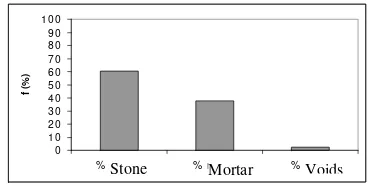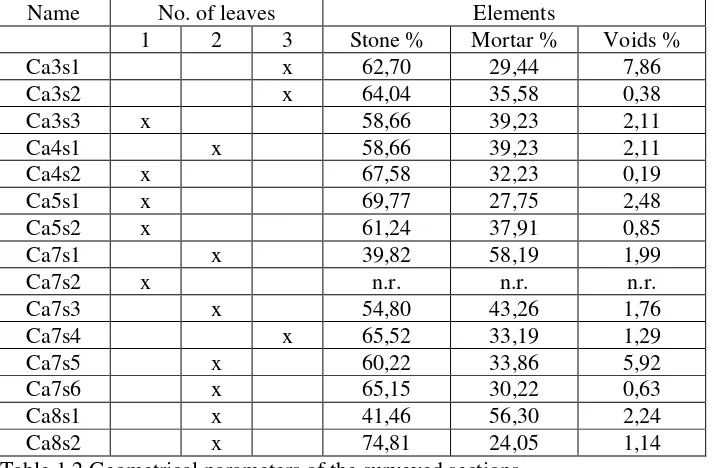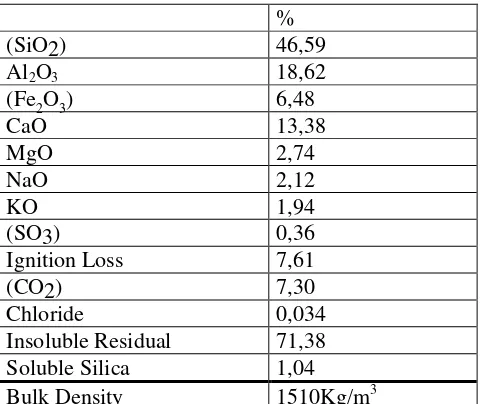See discussions, stats, and author profiles for this publication at: https://www.researchgate.net/publication/265480540
MORPHOLOGICAL AND MECHANICAL
CHARACTERISTICS OF MASONRIES AND
MATERIAL PROPERTIES
ARTICLE
READS
15
4 AUTHORS, INCLUDING:
Luigia Ada Binda
Politecnico di Milano
188 PUBLICATIONS 1,630 CITATIONS
SEE PROFILE
MORPHOLOGICAL AND MECHANICAL CHARACTERISTICS OF
MASONRIES AND MATERIAL PROPERTIES
L. Binda, G. Baronio, G. Mirabella Roberti, D. Penazzi
1. SURVEY ON TEXTURE AND SECTIONS OF SOME MASONRY WALLS
Eight buildings were the object of the survey, including the two chosen as case-study for multidisciplinary complete research within the Catania Project 1998, thanks to the collaboration between the GNDT Group and the local Authorities.
Since it was impossible to inspect the inside of the walls of these two buildings due to the fact that rendering could not be destroyed, only the texture and inside of the walls of the other six buildings were surveyed.
1.1Texture of the masonry walls
The complete survey was possible or six sites thanks to the fact that some ruins were available or works were carried out for repair and restoration of the some buildings. Sixteen sections (Table 1.1) were surveyed and studied first of all according to the bonding technique and to the stone shape and dimensions (Binda 1999, Binda et al., 1999b).
Name Location Studied walls
Ca3 Via Vittorio Emanuele Ca3p1, Ca3p2, Ca3p3
Ca4 Via Consolazione Ca4p1, Ca4p2
Ca5 Via Consolazione Ca5p1, Ca5p2
Ca6 Church S. Nicolò Ca6p1
Ca7 Province Building Ca7p1, Ca7p2, Ca7p3, Ca7p4, Ca7p5, Ca7p6
Ca8 Via Dusmat Ca8p1, Ca8p2
Table 1.1 Surveyed walls
Most frequently the stones are simply boasted, but often are more or less regular ashlars. A large use has been found of clay elements, such as bricks in the so called “intosto” masonries (see Fig. 1.2a) or roof tiles used as wedges in the external masonry leaves. The mortar joints are irregular or quasi-regular (sub-horizontal) (Fig. 1.1a). Fig.1.1b shows the overall percentual distribution of mortar, stone and voids over the surveyed sections.
Fig. 1.1a Distribution of horizontal courses Fig. 1.1b Material percentage
1.2Cross-sections of the walls
The surveyed sections were sixteen, but one was discarded due to the non-typical dimension, being 1300mm thick. In fact the most diffused wall type seems to be a double-leaf
0
corsi irreg. corsi sub.
masonry with a fairly good connection between the two leaves and average thickness of 65cm (Table 1.2).
Five cases belong to the so called “intosto” typology with an average thickness of 35cm. The “intosto” masonries were used typically during the last century in Sicily as partitioning walls; the horizontal courses were made alternatively with bricks and volcanic basalt units defined locally as “cannarozzone da intosta”. The ashlars were tooled and fairly regular with a height of 25-30cm.
Name No. of leaves Elements
1 2 3 Stone % Mortar % Voids %
Ca3s1 x 62,70 29,44 7,86
Ca3s2 x 64,04 35,58 0,38
Ca3s3 x 58,66 39,23 2,11
Ca4s1 x 58,66 39,23 2,11
Ca4s2 x 67,58 32,23 0,19
Ca5s1 x 69,77 27,75 2,48
Ca5s2 x 61,24 37,91 0,85
Ca7s1 x 39,82 58,19 1,99
Ca7s2 x n.r. n.r. n.r.
Ca7s3 x 54,80 43,26 1,76
Ca7s4 x 65,52 33,19 1,29
Ca7s5 x 60,22 33,86 5,92
Ca7s6 x 65,15 30,22 0,63
Ca8s1 x 41,46 56,30 2,24
Ca8s2 x 74,81 24,05 1,14
Table 1.2 Geometrical parameters of the surveyed sections
Three walls appeared to be three-leaf walls but in two of them one extenal leaf had been built in bricks and added after the construction of the wall. The data concerning the surveyed sections are reported in Table 1.2. From the same table it can be seen that the void percentage is usually very low (<3%). This information can be very useful when deciding the repair and strengthening technique to be applied (Binda et al., 1997). Fig. 1.2 shows the most representative cross-section among the surveyed ones.
Fig. 1.2 Some types of sections: a) “intosto”, b) two-leaves partially connected, c)three-leaves
1.3Laboratory analyses and tests on materials.
From the walls of the buildings Ca3 and Ca4 some stones and mortars were sampled and characterised through laboratory tests.
Brick
Stone
Brick
1.3.1 Analysis of mortars
From the building Ca3 two mortars were sampled and identified as Ca3p3.2m and Ca3p5.3m.The chemical analyses allowed to detect the calcareous nature of the binder and a very good level of carbonation. The aggregate is of volcanic origin, siliceous with rare carbonaceous pebbles. The petrographic-mineralogical analysis did not detect any pozzolanic reaction between binder and aggregate as usually expected when dealing with volcanic
materials. The bulk density was respectively 1561 and 1623 kg/m3, quite low if compared to
other traditional mortars prepared without volcanic aggregates.
1.3.2 Physical and mechanical tests on stones
From the ruins of the building situated in via della Consolazione and referred as Ca4 two stone ashlars and one brick were sampled and used for laboratory tests. They were sampled as follows: a) an irregular stone named Ca4.2 from the wall section Ca4s1, a two-leaf well connected wall 68cm thick, b) a brick called Ca4.1 and an ashlar called Ca4.3 from the single-leaf section, 20cm thick called Ca4s2.
The thin section analysis under petrographic microscope has shown the following characters: - Ca4.2: vesicular volcanic rock with rare microphenocrysts of plagioclase in very fine
grained groundmass;
- Ca4.3: basaltic volcanic rock with porphyritic structure, containing plagioclase microphenocrysts in glassy groundmass and phenocrysts, mainly of geminate plagioclase, subordinately of pyroxene and olivine.
Eight cylinders (5 from Ca4.2 and 3 from Ca4.3) of 5cm diameter and 10cm height were cored from the stones. The cylinders were submitted before to physical tests and later to mechanical compressive and splitting tests; these last were only possible for Ca4.2. From the brick, cubes of 35mm side were sampled for splitting and compressive tests. Table 1.3 gives the results of the tests.
It is clear that the mechanical and physical characteristics of the volcanic stones can be very different.
coefficient g/cm2s0,5
Ca4.1 4.96 820 0.81 1.788
Ca4.2 34.9 7765 3.88 0.0926
Ca4.3 119.7 13797 / 0.035
Table 1.3 Mechanical and physical characteristics of stones
2. INVESTIGATION ON MATERIALS AND MASONRIES OF THE TWO
REFERENCE BUILDINGS
For each of the two buildings examined, a description form was prepared as described in
(Binda et al. 1999a). Section surveys and sampling of stones were impossible due to the fact
2.1Ca1 Building: mortar analyses
A sample taken from the Via Verdi building was analysed: the mortar appeared to be very consistent and of reddish colour. Visual inspection shows red pebbles, calcite pebbles and
fragment of basaltic stone (Fig. 2.1). The specimen was named Ca1 p.2m and was sampled
from the CTJ1D test location. The chemical analysis reported in Table 2.1 shows the
calcareous nature of the binder, a high level of carbonation and the siliceous nature of the aggregate. The soluble silica content is very high compared to a traditional mortar based on hydrated lime.
The petrographic mineralogical analyses confirmed the results of the chemical one. The presence of a high percentage of soluble silica can be due to a pozzolanic reaction between the binder and the volcanic aggregate particularly the high porous one; in fact reaction borders can be seen around some volcanic aggregates (Fig. 2.2) (Baronio et al., 1994).
Fig. 2.1 Mortar sample from Ca1 building
Fig. 2.2 Thin section of Ca1 p2m with reaction layers
2.2Flat-jack tests
Three double flat-jack tests were carried out on the masonries of the Ca1 and Ca2 buildings: respectively two at Ca1 (CTJ1D, CTJ2D) and one at Ca2 (CTJ3D). The stress-strain curves obtained are reported in Fig. 2.3a,b,c. The following maximum stress values were reached, which can be considered around the 70% of the real peak stresses, during the
tests: 2.27, 2.24, 2.59 N/mm2 respectively for CTJ1D, CTJ2D and CTJ3D. These values and
Fig. 2.3a,b,c Stress-strain curves obtained from CTJ1D, CTJ2D, CTJ3d respectively %
Bulk Density 1510Kg/m3
Table 2.1 Chemical analysis of the sample Ca1 p2m
-1.0 -0.5 0.0 0.5 1.0 1.5 2.0
Deformazioni [µm/mm]
the stress-strain behaviour detected indicate by experience of the authors a good masonry (Binda et al., 1999c). The weakest behaviour was definetely shown by CTJ2D which was carried out on a wall added after the construction of the building. Table 2.2 also gives other calculated mechanical parameters.
E sec. [N/mm2] ∆εl/∆εv
Load interval [N/mm2] Load interval [N/mm2]
Name of the Test
max σ
applied
[N/mm2]
0,4÷1 1,2÷1,8 0,4÷1 1,2÷1,8
CTJ1D via Verdi 2,27 5200 2300 0,15 0,13
CTJ2D via Verdi 2,24 1400 550 (1,01) (0,81)
CTJ3D via Martoglio 2,59 4700 2400 0,38 0,43
Tab. 2.2 Flat-jack results
3. CONCLUSIONS
The experimental investigation carried out on the Catania buildings allowed to apply with success the methodology proposed by the authors. The section survey informs on the morphology of the walls, on the number of leaves they are formed with, on the type of connection between the leaves and on the presence and distribution of voids. These are important information for the structural analysis and for an appropriate choice of strengthening. The laboratory tests are useful to characterise the component materials, mortars, bricks and stones in order to choose the new materials for repair. The flat-jack test is at present the only on site mechanical test to give quantitative information on the local state of stress and on the masonry mechanical behaviour.
4. REFERENCES
Baronio G., Binda L. (1994). Study of the pozzolanicity of stone bricks and clays, 10th Int.
Brick/Block Masonry Conf., Calgary, 3, 1189-1197. Publ. in Construction and Building
Materials, (134), 1-6, 1997.
Binda L., Modena C., Baronio G., Abbaneo S. (1997). Repair and investigation thecniques for
stone masonry walls, Construction and Building Materials, Vol. 11, N.3, pp. 133-142.
Binda L. (1999). Caratterizzazione delle murature in pietra e mattoni ai fini dell’individuazione di opportune tecniche di riparazione, Unità di Ricerca di Milano, Relazione Finale, Contratto CNR/GNDT.
Binda L., Baronio G., Penazzi D., Palma M., Tiraboschi C. (1999a). Caratterizzazione di Murature in Pietra in Zona Sismica: Data-Base sulle Sezioni Murarie e Indagini sui
Materiali, 9th Conv. Ing. Sismica, Torino, to appear
Binda L., Palma M., Penazzi D. (1999b). Investigation before and after the intervention for a cautious repair of stone-masonry structures in seismic areas, Conf. on Arbeitshette des SFB 315, Karlsruhe.
Binda L., Tiraboschi C., (1999c). Flat-jack Test as a Slightly Destructive Technique for the
Diagnosis of Brick and Stone Masonry Structures, 8th Int. Conf. and Exhibition,


